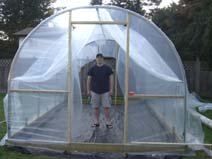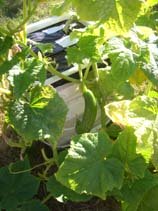|
Greenhouse Glazing:Greenhouse Glazing is the material that covers the greenhouse frame. The term glazing refers to any transparent material, like traditional glass, used to cover greenhouse frames that allow light and retain heat in the greenhouse. Want to know what the glass of a greenhouse does – check out the video below - I couldn’t get it out of my head – stay stay long heat waves.
Many new greenhouse glazing materials have emerged in recent years.
Light Penetration:Great care must be placed in choosing a glazing material that allows the most light into the greenhouse. It is the solar rays that enter the greenhouse that will allow the greenhouse to retain the heat. If the material does not allow a lot of light into the greenhouse it kind of defeats the purpose.
So how What does the Glass of A Greenhouse Do? Here's the Video:
Ease of Installation:If one is building their own greenhouse, ease of installation is important to keep in mind. Most of the greenhouse kits that are available should be fairly easy to put together. The ease of installation is, let’s say, pretty easy. But just keep it in mind, for instance glass can be somewhat dangerous to work with if it breaks or shatters, it can also weigh quite a bit. All options should be weighed. Reparability:If the glazing material should have some damage, how difficult will it be to repair? Is it a matter of patching the tear, as in polycarbonate or poly film? Or will the whole panel need to be replaced as in glass? Budget:Not all greenhouse glazing materials are created equal, and their costs are no different. The greenhouse covering represents the largest cost of any of the kits that are available on the market. That’s why even when choosing a kit – the type of glazing should be decided before the shopping or building begins. Lifespan:I know that maybe I sound like I am not a great supporter of glass, and in fact it is not the material that I would choose, or chose to use in my greenhouse. However, glass is hands down the longest lasting of the greenhouse glazes (as long as it doesn’t break). Durability:In every climate, environment, or location the greenhouse will have to stand up to different threats. Whether it is hail, wind, snow, rocks or different debris. Different hazards in different locations or maybe none at all, but also a good thing to keep in mind when making the decision. UV rays can also cause damage and deterioration of the glazing. It is also a good idea to make sure that when choosing the glazing to make sure that it has been treated to protect it from the harsh UV rays. Heat Retention:The insulating factor of the different greenhouse glazing materials should be kept in mind when deciding on the type of covering that will be used to cover a greenhouse. In deciding this the climate, environment and plant zone should be kept in mind. This will dictate the amount of heat retention that will be needed. Growing in a warmer climate will need less of a heat retaining material then a greenhouse in a colder climate. However, any of the greenhouse glazing materials can be better insulated by adding a sheet of poly on the inside of the original Glazing. This creates an insulating air space between the inside of the greenhouse and the outside temperature. Poly hoop houses can be insulated with an air blower that inflates this air space, greatly increasing the heat retention. |
Please Help Us Get Social:
Valued Links and Featured Sites:
Greenhouse Plans
Free Greenhouse Gardening Construction Plans
"Ole Dirt Farmer"

Self Watering Container Plans
Don't want to make your own. There is also information about Earthboxes too.
These are great, either or.
Free Self Watering Container Plans
Jonathan White: Food 4 Wealth
It is a great fit. Be sure to take a look. Jonathan is a passionate guy. See below for our full review.
Aquaponic Plans
Links on this page will take you to Travis's free e-book.
A Malispina college student shares a video of her completed Barrelponic project. Complete with Tilapia.
Free Aquaponics (Fish and Vegetables) Plans










